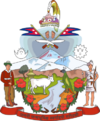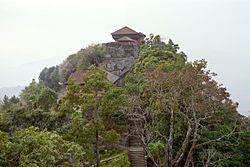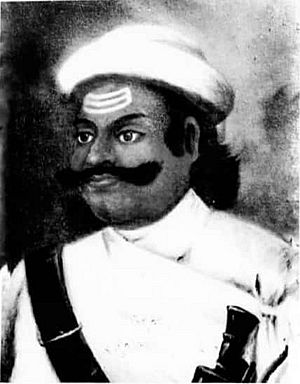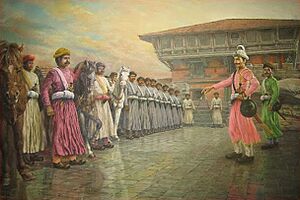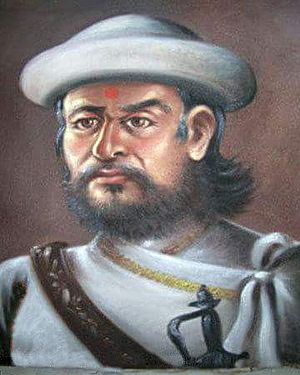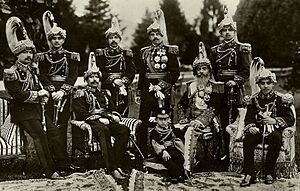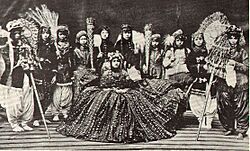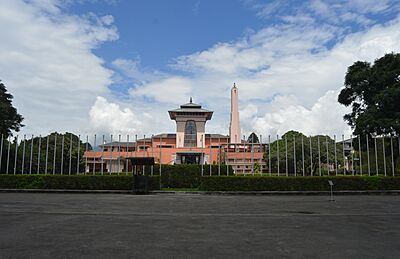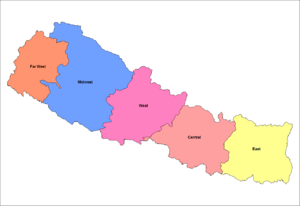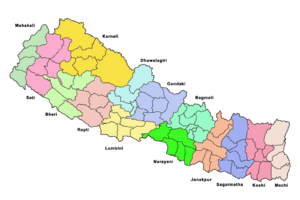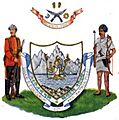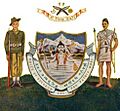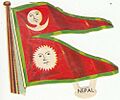Kingdom of Nepal facts for kids
Quick facts for kids
Kingdom of Nepal
|
|||||||||||||||||||||||||||||
|---|---|---|---|---|---|---|---|---|---|---|---|---|---|---|---|---|---|---|---|---|---|---|---|---|---|---|---|---|---|
| 1768–2008 | |||||||||||||||||||||||||||||
|
Motto: Janani Janmabhūmishcha Swargādapi Garīyasī (Sanskrit)
Mother and Motherland are greater than heaven |
|||||||||||||||||||||||||||||
|
Anthem: 1962–2006:
"Srīmān Gambhīr" (Nepali: श्रीमान गम्भीर) (English: "May Glory Crown You, Courageous Sovereign") 2007–2008: "Sayauṁ thum̐gā phūlakā" (Nepali" सयौँ थुँगा फूलका) (English: "Made of Hundreds of Flowers") |
|||||||||||||||||||||||||||||
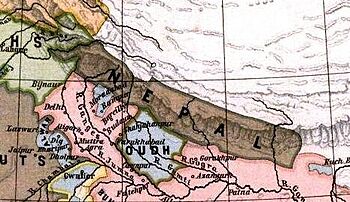
Territory of the Kingdom of Nepal in 1808
|
|||||||||||||||||||||||||||||
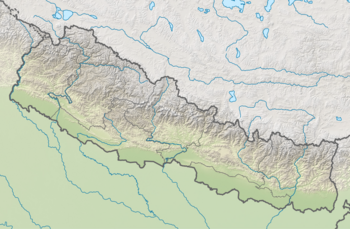
Territory of the Kingdom of Nepal in 2008
|
|||||||||||||||||||||||||||||
| Status |
|
||||||||||||||||||||||||||||
| Capital and largest city
|
Kathmandu 27°42′N 85°19′E / 27.700°N 85.317°E |
||||||||||||||||||||||||||||
| Common languages | Nepali (official) Newari (official, literature and administration language in the initial period) Other native language in Nepal |
||||||||||||||||||||||||||||
| Religion | Hinduism (official) | ||||||||||||||||||||||||||||
| Demonym(s) | Nepalis, Nepalese |
||||||||||||||||||||||||||||
| Government | Unitary absolute monarchy (1768–1990; 2002; 2005–2006)
Unitary parliamentary constitutional monarchy
|
||||||||||||||||||||||||||||
| Mahārājādhirāja | |||||||||||||||||||||||||||||
|
• 1768–1775 (first)
|
Prithvi Narayan Shah | ||||||||||||||||||||||||||||
|
• 2001–2008 (last)
|
Gyanendra Shah | ||||||||||||||||||||||||||||
| Prime Minister | |||||||||||||||||||||||||||||
|
• 1799–1804 (first)
|
Damodar Pande | ||||||||||||||||||||||||||||
|
• 2006–2008 (last)
|
Girija Prasad Koirala | ||||||||||||||||||||||||||||
| Legislature |
|
||||||||||||||||||||||||||||
| Senate (1959–1960) National Assembly (1990–2002) |
|||||||||||||||||||||||||||||
| House of Representatives (1959–1960; 1990–2002) |
|||||||||||||||||||||||||||||
| History | |||||||||||||||||||||||||||||
|
• Unification under Prithivi Narayan Shah
|
25 September 1768 | ||||||||||||||||||||||||||||
|
• Thapa premiers
(under Shah kings) |
1806–1837 and 1843–1845 |
||||||||||||||||||||||||||||
|
• Pande premiers
(under Shah kings) |
1799–1804 and 1837–1840 |
||||||||||||||||||||||||||||
|
• Rana regime
(under Shah kings) |
1846–1951 | ||||||||||||||||||||||||||||
|
• Panchayat system
|
1960–1990 | ||||||||||||||||||||||||||||
| 1990–2008 | |||||||||||||||||||||||||||||
|
• Republic
|
28 May 2008 | ||||||||||||||||||||||||||||
| Currency |
|
||||||||||||||||||||||||||||
| ISO 3166 code | NP | ||||||||||||||||||||||||||||
|
|||||||||||||||||||||||||||||
| Today part of | Nepal India China Bangladesh |
||||||||||||||||||||||||||||
The Kingdom of Nepal (Nepali: नेपाल अधिराज्य) was a Hindu kingdom in South Asia. It was formed in 1768 when the Gorkha Kingdom expanded and united many smaller states. This kingdom lasted until 2008. Then, it became the Federal Democratic Republic of Nepal. It was also known as the Gorkha Empire (Nepali: गोरखा अधिराज्य). Sometimes, it was called Asal Hindustan (Nepali: असल हिन्दुस्तान, lit. 'Real Land of the Hindus').
King Prithvi Narayan Shah founded the kingdom. He was a Gorkha ruler. The kingdom existed for 240 years. During this time, the Shah dynasty ruled Nepal. Their power changed over the years.
After 1792, Nepali forces invaded Tibet. The Dalai Lama and Chinese officials asked China for military help. Chinese and Tibetan forces attacked Nepal. They later negotiated after failing at Nuwakot. Mulkaji Damodar Pande became a powerful leader.
In 1804, former King Rana Bahadur Shah returned. He took control and Damodar Pande was executed. The 1806 Bhandarkhal massacre led to the rise of Bhimsen Thapa. He became the main ruler of Nepal from 1806 to 1837. In the early 1800s, the East India Company grew stronger in India. This led to the Anglo-Nepalese War (1814–1816). Nepal lost this war.
Under the Treaty of Sugauli, Nepal kept its independence. But it gave up large areas of land. The Mechi and Sharda rivers became the new borders. The land before this treaty is sometimes called Greater Nepal. Later, the death of Mathbar Singh Thapa led to the Kot massacre. This event brought the Rana dynasty to power. The Prime Minister's job became hereditary in their family. This lasted for about 100 years, from 1843 to 1951.
Jung Bahadur Rana was the first Rana ruler. The Rana dynasty made the Shah king a figurehead. This meant the king had little real power. The Rana rule was known for being harsh and unfair.
In 1950, India signed a friendship treaty with Nepal. Both nations agreed to respect each other. They also agreed to have an open border. In November 1950, India helped King Tribhuvan. The Rana leader had tried to remove him from power. With India's help, King Tribhuvan ended the Rana rule in 1951.
Nepal tried to make reforms and create a constitution in the 1960s and 1970s. An economic crisis in the late 1980s caused a popular movement. This led to parliamentary elections and a constitutional monarchy in 1990. The 1990s also saw the start of the Nepalese Civil War (1996–2006). This was a fight between the government and the Maoist rebels. The monarchy became even more unstable after the 2001 Nepalese royal massacre.
After the massacre, King Gyanendra returned to the throne. He took direct control in 2005. This caused a protest movement. Maoist rebels and pro-democracy groups joined forces. King Gyanendra was forced to bring back the House of Representatives. In 2007, an interim constitution was adopted. This greatly limited the king's powers. After an election in 2008, the Nepalese Constituent Assembly officially ended the kingdom. On May 28, 2008, Nepal became the Federal Democratic Republic of Nepal.
Until the monarchy ended, Nepal was the only country in the world with Hinduism as its official state religion. Now, as a republic, it is a secular state.
Contents
History of the Kingdom of Nepal
How Nepal Began
Early Origins of the Kingdom
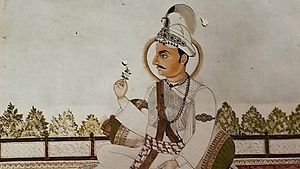
The country grew from a small state called the Gorkha Kingdom. This was one of the Chaubise principalities. In Nepal, warrior people are called 'Gorkhalis'. This means 'people from Gorkha'. Their famous battle cry is "Jai Kali, Jai Gorakhnath, Jai Manakamana".
The name 'Gorkha' comes from the Hindu saint Gorakhnath. In Gorkha village, there is a temple for Gorakhnath. There is also a temple for Gorakhkali, a goddess. These temples were likely built around the year 1000 AD.
Before the Shah family ruled Gorkha, Magars lived there. They were the largest ethnic group. Dravya Shah captured the Liglig-kot kingdom from the Magar King Dalsur Ghale Magar. Gangaram Rana Magar helped Dravya Shah. In 1559 AD, Dravya Shah defeated King Mansingh Khadka Magar. This started Shah rule in Gorkha. Prithvi Narayan Shah was the ninth ruler in the Shah family. He became king in 1742 AD.
Expanding the Kingdom
King Prithvi Narayan Shah of the small Gorkha Kingdom created the Gorkhali Army. The army's leaders came from noble Chhetri families of Gorkha. These included the Pande family, Basnyat family, and Thapa dynasty. Kaji Kalu Pande was the first civilian army chief. He played a big role in uniting Nepal.
The Battle of Nuwakot
The first battle by King Prithvi Narayan Shah's united Gorkhali forces was the Battle of Nuwakot. Kaji Kalu Pande led the army. Jayant Rana Magar was appointed General by the King of Kantiur to defend Nuwakot. Pande planned a surprise attack on Nuwakot. It was an important fort for the Malla king of Kathmandu.
On September 26, 1744, Pande and his soldiers climbed the northern side of Nuwakot city. They launched a surprise attack with the Gorkhali war cry. The Nuwakot soldiers tried to defend but lost. Their commander was killed by the king's 13-year-old brother, Dal Mardan Shah. Other Gorkhali forces also won their battles. The king himself advanced to the Nuwakot fort. The panicked soldiers fled, and Gorkha took over Nuwakot.
The Battle of Kirtipur
Kaji Kalu Pande at first thought the Gorkhalis were not ready for battle. But the king insisted, so Pande agreed to fight the kingdom of Kirtipur. Kirtipur is in the Kathmandu valley. The Gorkhalis set up their base in Naikap. They used swords, bows, arrows, and muskets. The two armies fought on the plain of Tyangla Phant.
The king's brother, Surapratap Shah, lost an eye during the battle. The Gorkhali commander Kaji Kalu Pande was surrounded and killed. The Gorkhali king barely escaped by disguising himself as a saint. In 1767, King Prithvi Narayan Shah sent his army to attack Kirtipur a third time. The three kings of the valley tried to help Kirtipur, but they failed. A noble from Lalitpur helped the Gorkhalis enter the town.
Taking Over Makwanpur & Hariharpur
King Digbardhan Sen and his minister had sent their families away. The Gorkhalis attacked on August 21, 1762. The battle lasted eight hours. The king and his minister escaped. Makawanpur was then taken by the Gorkhali forces.
After taking Makawanpurgadhi fort, the Gorkhalis planned to attack Hariharpurgadhi. This was a key fort on a mountain ridge south of Kathmandu. It controlled the path to the Kathmandu valley. On October 4, 1762, the Gorkhalis attacked. The Hariharpur soldiers fought bravely but had to leave the fort after midnight. About 500 Hariharpur soldiers died.
Mir Qasim, the Nawab of Bengal, sent his forces to help the kings of Kathmandu valley. But on January 20, 1763, Gorkhali commander Vamsharaj Pande won the battle against Mir Qasim. Captain Kinloch of the British East India Company also sent help against the Gorkhalis. King Prithvi Narayan sent his commanders to defeat these forces at Makwanpur.
Conquering Kathmandu Valley and Declaring the Kingdom
Winning the Battle of Kirtipur was a big step for Shah. It completed his twenty-year effort to take the rich Kathmandu valley. After Kirtipur fell, Shah took Kathmandu and Lalitpur in 1768. He then took Bhaktapur in 1769. This completed his control of the valley.
King Prithvi Narayan Shah had been sad about Kaji Kalu Pande's death. He thought it would be impossible to conquer the valley without him. But after taking the valley, the king praised the bravery and wisdom of his commanders. Vamsharaj Pande, Kalu Pande's oldest son, led the attack during the Battle of Bhaktapur on April 14, 1769.
Conquering the Kirata Region
King Prithvi Narayan Shah sent Sardar Ram Krishna Kunwar to invade the Kirata areas. These included Pallo Kirant, Wallo Kirant, and Majh Kirant. On August 29, 1772, Kunwar crossed the Dudhkoshi river. He invaded King Karna Sen's region with commander Abhiman Singh Basnyat. He then crossed the Arun river to Chainpur. There, he won against the Kiratas. King Prithvi Narayan Shah gave Ram Krishna Kunwar special honors for his victory.
Political Struggles in the Kingdom
In 1775, King Prithvi Narayan Shah died in Nuwakot. He was the king who had expanded the Gorkha Kingdom into Nepal. Swarup Singh Karki, a clever courtier, confined Prince Bahadur Shah. This happened with the approval of the new King Pratap Singh Shah. Swarup Singh was promoted to Kaji. He later exiled Bahadur Shah and others.
King Pratap Singh Shah's rule had a constant rivalry between Swarup Singh and Vamsharaj Pande. King Pratap Singh Shah died in 1777. His infant son Rana Bahadur Shah became king. Sarbajit Rana Magar was made a Kaji. Later, rivalry grew between Prince Bahadur Shah and Queen Rajendra Laxmi. Sarbajit Rana supported the Queen.
Prince Bahadur Shah confined Queen Rajendra Laxmi in 1778. He accused her of having a secret relationship with Sarbajit Rana Magar. Sarbajit was then executed inside the palace. This event marked the start of many court conspiracies and killings in Nepal. Historians say that the murder of Sarbajit Rana Magar was an injustice.
Vamsharaj Pande, a former minister and son of Kalu Pande, was executed. He was accused of helping the King of Parbat escape a battle. Swaroop Singh accused him. Vamsharaj was found guilty and executed in 1785. On July 2, 1785, Swaroop Singh's opponent, Prince Regent Bahadur Shah, was arrested. But on July 13, Queen Rajendra Laxmi, Singh's only supporter, died. Bahadur Shah then became the regent for King Rana Bahadur Shah. He ordered Swaroop Singh to be executed for treason.
Conflict with Tibet
After Prithvi Narayan Shah died, the Shah dynasty continued to expand. Between 1788 and 1791, Nepal invaded Tibet and looted a monastery. Tibet asked China for help. The Qianlong Emperor of China sent an army. Both sides suffered heavy losses. The Nepali forces retreated to Nuwakot. They wanted to stretch out the Chinese and Tibetan forces.
The Chinese attacked uphill during the day but failed. They faced strong counterattacks with khukuri knives at Nuwakot. The Chinese army had problems crossing a flooded river. A standstill followed. The Chinese commander wanted to negotiate. The treaty that followed was more favorable to China. Nepal had to send gifts to the Chinese emperor.
The 1800s in Nepal
Damodar Pande's Influence
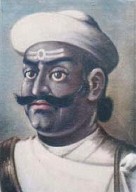
Damodar Pande became one of the four chief ministers in 1794. This happened after King Rana Bahadur Shah removed Bahadur Shah. Pande was the most powerful among the court groups. King Rana Bahadur Shah's behavior became difficult. This led to a civil war. Damodar was against the king. He had to flee to Varanasi in 1800.
In 1802, Queen Rajrajeshwari became regent. She appointed Damodar Pande as the chief minister. When Rana Bahadur returned to power, he ordered Damodar Pande and his two innocent sons to be executed. This happened on March 13, 1804. Many of Pande's supporters were also executed or fled to India. After Pande's execution, his cousin Ranajit Pande became chief minister. Bhimsen Thapa became the second chief minister.
The Thapa Family Takes Power
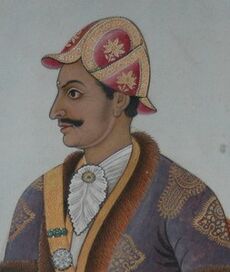
The Thapa family, who were Kshatriya, gained power in 1806. This was when King Rana Bahadur Shah was killed. Bhimsen Thapa (1775–1839), a leading Thapa chief minister, used this chance. He killed about 55 military and civil officers. This brought the Thapas to power. He took the title of Mukhtiyar. He became the main authority. His niece Queen Tripurasundari became Queen Regent for the young King Girvan Yuddha Bikram Shah.
War with the British

Nepal and the East India Company had disagreements. These were about the small states bordering Nepal and India. This led to the Anglo-Nepalese War (1814–16). The Treaty of Sugauli was signed in 1816. Nepal gave up large parts of its land, including the Terai and Sikkim. This was about one-third of the country. In return, Nepal kept its independence.
When India became independent from British rule, these lands were not returned to Nepal. Most of them became part of India. Sikkim remained independent until it joined India in 1975. However, in 1860, the British returned some land in the Terai to Nepal. This was a thank you for Nepal's help during the Indian Rebellion of 1857. This returned land is known as Naya Muluk (new country).
The Rana Family's Rule
After the war, the royal family had many disagreements. This caused a time of instability. In 1846, Queen Rajya Lakshmi Devi planned to remove Jung Bahadur Rana. He was a rising military leader who threatened her power. The plan was discovered. The queen had hundreds of princes and chiefs killed. This happened after a fight between soldiers loyal to the queen and Jung Bahadur. This event is known as the Kot Massacre.
Jung Bahadur won and started the Rana dynasty. The king became a figurehead. The job of Prime Minister became very powerful and was passed down in the Rana family. This lasted for the next century.
Third War with Tibet
Jung Bahadur Rana sent forces to attack Tibet again. His brothers Bam Bahadur Kunwar and Dhir Shamsher Rana led the forces. They defeated Tibetan forces on two sides. A Tibetan team arrived in January 1856 to sign a treaty. After a month, the Treaty of Thapathali was signed. This treaty was more favorable to Nepal.
The 1900s in Nepal
Nepal and the British Empire
The Rana government was a very strict, centralized rule. They kept Nepal isolated from outside influences. This helped Nepal stay independent during the British colonial era. But it also slowed down the country's economic growth and modernization. The Ranas strongly supported the British. They helped the British during the Indian Rebellion of 1857 and both World Wars. The British also supported Nepal's independence.
In December 1923, Britain and Nepal signed a treaty of peace and friendship. This replaced the 1816 Sugauli Treaty. It also changed the British resident in Kathmandu to an envoy. Slavery was ended in Nepal in 1924.
Steps Towards Democracy
People started to become unhappy with the Rana family's rule. Some educated Nepalis had studied in India. Many of them had helped in India's independence fight. They wanted to free Nepal from the Rana's strict rule. Political parties like the Praja Parishad and Nepali Congress were formed. Leaders like B.P. Koirala and Ganesh Man Singh urged for a movement to overthrow the Rana government. Some people who fought for this cause were killed by the Ranas.
In 1950, King Tribhuvan, a direct descendant of Prithvi Narayan Shah, escaped his palace. He went to newly independent India. This started a revolt against the Rana government. Eventually, the Shah family returned to power. A non-Rana became prime minister. For a while, the king and new political parties governed the country. In the 1950s, efforts were made to create a constitution for Nepal. This constitution would set up a representative government.
In early 1959, King Tribhuvan's son, King Mahendra, issued a new constitution. The first democratic elections for a national assembly were held. The Nepali Congress, a socialist group, won many seats. Its leader, B.P. Koirala, became prime minister. But after some power struggles, King Mahendra ended the democratic system in 1960.
King Mahendra's New System
King Mahendra said the parliament was failing. In 1960, he dismissed the Koirala government. He declared that a "party-less" Panchayat system would rule Nepal. He announced a new constitution on December 16, 1962.
The Prime Minister, members of parliament, and many democratic activists were arrested. This continued for 30 years under King Mahendra and his son, King Birendra.
The new constitution created a "party-less" system of panchayats (councils). King Mahendra believed this was a democratic way to govern. It gave the king absolute power. He was the head of state and controlled all government parts. Nepali became the official language.
King Mahendra died in 1972. His 27-year-old son, King Birendra, became king. In 1979, there were student protests. King Birendra called for a national vote. People would decide if they wanted the panchayat system with reforms or a multiparty system. The vote was in May 1980. The Panchayat system won by a small margin. The king made the promised reforms.
End of the Panchayat System
People were unhappy with the strict government. Political parties had limited freedom. Many felt the palace did not represent the people. For example, the government faced scandals over money for earthquake victims. Also, trade relations with India became bad.
In 1987, Nepal required work permits for Indian workers in some areas. In 1989, Nepal gave special duty breaks to Chinese goods. It removed them from Indian goods. This made Chinese goods cheaper. Relations worsened, especially after Nepal bought Chinese weapons in 1988. India refused to renew trade treaties. This caused a deadlock. The lack of trade hurt the lower classes in Nepal. Industries also suffered. The government tried to get foreign aid. But many people wanted negotiations with India.
The Nepali Congress (NC) and left-wing parties blamed the government. They said the government caused the crisis. In December 1989, the NC started a public awareness program. The United Left Front (ULF) supported the NC. On January 18–19, 1990, the NC held a conference. Leaders from other countries attended. Inspired by international support, the NC and ULF started a mass movement on February 18. They wanted to end the Panchayat rule and create a new government.
On April 6, the government was dismissed. A new Prime Minister was appointed. But the protesters were not satisfied. They wanted to end the party-less system itself. On April 16, the new government was also dismissed. The next day, the king announced that political parties could function again. Many civilians were killed during these protests. They were later seen as 'undeclared martyrs'.
The 1990 People's Movement
People in rural areas hoped for better representation after 1990. The Nepali Congress and leftist parties launched a big protest. This was called Jana Andolan. It forced the monarchy to accept reforms. A multiparty parliament was established. In May 1991, Nepal held its first parliamentary elections in almost 50 years. The Nepali Congress won and formed the first elected government in 32 years.
Civil Unrest
In 1992, Nepal faced economic problems. Prices went up due to new government policies. Radical left groups increased their protests. A Joint People's Agitation Committee was formed. They called for a general strike on April 6.
Violence started the evening before the strike. Activists tried to enforce a 'lights out' in the capital. Clashes happened outside a hospital. On April 6, clashes between protesters and police left two activists dead.
Later that day, police attacked a large rally in Kathmandu. Riots broke out. The Nepal Telecommunications building was set on fire. Police shot into the crowd, killing several people. A human rights group estimated that 14 people were killed.
When promised land reforms didn't happen, people in some areas started their own reforms. They wanted more power over their lives. But the Nepali government stopped this movement. Many activists were killed. This made many people angry and more radical.
The Nepalese Civil War
In February 1996, a Maoist party began a fight. They wanted to replace the monarchy with a new democratic republic. This was through a Maoist revolutionary plan called the people's war. This led to the Nepalese Civil War. The insurgency started in five districts: Rolpa, Rukum, Jajarkot, Gorkha, and Sindhuli. The Maoists declared a temporary "people's government" in several areas.
The 2000s in Nepal
The Royal Palace Tragedy
On June 1, 2001, Crown Prince Dipendra was involved in a shooting. Nine members of the royal family were killed. This included King Birendra and Queen Aishwarya. Dipendra temporarily became king but died from his wounds. Then, Prince Gyanendra (Birendra's brother) became king. This event shocked the country. It showed that the Royal Family had human problems, not just a mythical image.
Meanwhile, the Maoist rebellion grew. In October 2002, the king temporarily removed the government. He took full control. A week later, he appointed another government. But the country remained unstable. This was due to the civil war, political groups, and the king's attempts to gain more power. There were also worries about the king's son and heir, Prince Paras.
King Takes Full Control
Unstable governments and a Maoist siege on Kathmandu Valley in August 2004 caused support for the monarchy to drop. On February 1, 2005, King Gyanendra dismissed the entire government. He took executive powers without ministerial advice. He declared a "state of emergency" to stop the Maoist movement. Politicians were put under house arrest. Phone and internet lines were cut. Freedom of the press was greatly limited.
The 2006 Democracy Movement
The king's new rule made little progress against the rebels. The European Union called the municipal elections of February 2006 "a backward step for democracy." Major parties boycotted the election. The army forced some candidates to run. In April 2006, strikes and street protests in Kathmandu forced the king to bring back the parliament. A seven-party group took control of the government. They stripped the king of most of his powers. By January 15, 2007, a unicameral legislature under a temporary constitution governed Nepal.
The Monarchy Ends
The Constituent Assembly was formed on December 24, 2007. It was announced that the monarchy would end in 2008. This would happen after the Constituent Assembly elections. On May 28, 2008, Nepal was declared a Federal Democratic Republic.
Regions of Nepal
Nepal was divided into 14 zones and 75 districts. These were grouped into 5 development regions:
The five development regions of Nepal were (from east to west):
| No. | English name | Nepali name | Zones | Districts (No.) | Headquarters | Population | Area (km2) |
|---|---|---|---|---|---|---|---|
| 1 | Eastern Development Region | पुर्वाञ्चल विकास क्षेत्र | Mechi Koshi Sagarmatha |
16 | Dhankuta | 5,811,555 | 28,456 |
| 2 | Central Development Region | मध्यमाञ्चल विकास क्षेत्र | Janakpur Bagmati Narayani |
19 | Kathmandu | 9,656,985 | 27,410 |
| 3 | Western Development Region | पश्चिमाञ्चल विकास क्षेत्र | Gandaki Lumbini Dhaulagiri |
16 | Pokhara | 4,926,765 | 29,398 |
| 4 | Mid-Western Development Region | मध्य पश्चिमाञ्चल विकास क्षेत्र | Rapti Bheri Karnali |
15 | Birendranagar | 3,546,682 | 42,378 |
| 5 | Far-Western Development Region | सुदुर पश्चिमाञ्चल विकास क्षेत्र | Seti Mahakali |
9 | Dipayal | 2,552,517 | 19,539 |
Each district had a chief district officer. This officer was in charge of law and order. They also coordinated government work. The 14 zones were:
Government and Politics in the Kingdom
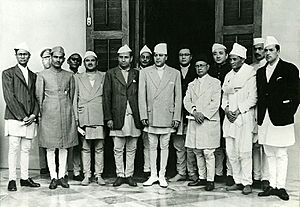

Until 1990, Nepal was an absolute monarchy. The king had all the power. But a people's movement protested against this. In 1990, King Birendra agreed to big political changes. He created a parliamentary monarchy. The king became the head of state. A prime minister became the head of the government.
Nepal's law-making body had two parts. These were the House of Representatives and a National Council. The House of Representatives had 205 members. People directly elected them. The National Council had sixty members. Ten were chosen by the king. Thirty-five were elected by the House of Representatives. The last fifteen were elected by village and town leaders. The legislature served a five-year term. But the king could dissolve it earlier. All Nepali citizens aged 18 and older could vote.
The executive branch included the King and the Council of Ministers (the Cabinet). The leader of the party that won the most seats became the Prime Minister. The king appointed the Cabinet based on the Prime Minister's advice. Governments in Nepal were often unstable. No government lasted more than two years after 1991. This was due to internal problems or the king dissolving parliament.
The movement in April 2006 changed the nation. The king was forced to give up power. The dissolved House of Representatives was brought back. This House of Representatives formed a government. It had successful peace talks with the Maoist Rebels. A temporary constitution was put in place. A temporary House of Representatives was formed with Maoist members. The number of seats increased to 330. The peace process made a big step in April 2007. The Communist Party of Nepal (Maoist) joined Nepal's temporary government.
Images for kids




